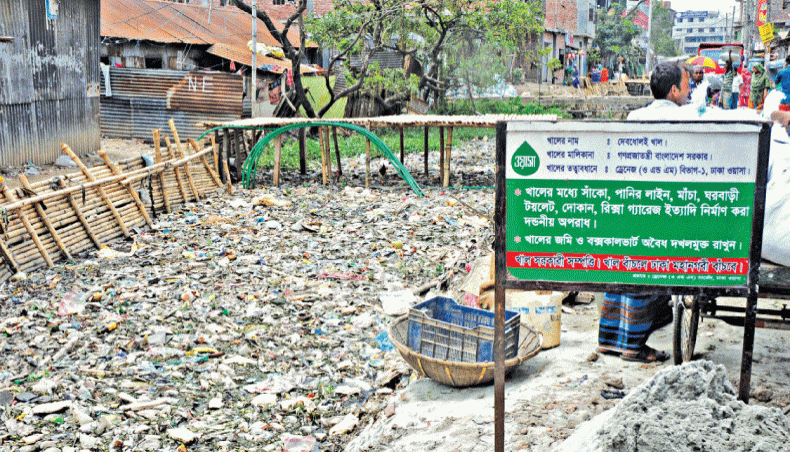RESTORING CAPITAL’S CANALS HC asks govt to submit action plan in 6 months
The High Court Division on Monday directed the government to prepare and submit within six months ‘a time-bound action plan’ for the recovery and restoration of the capital’s 50 canals by demarcating their boundaries according to their original flows.
The court also directed the government to enclose with the action plan the list of encroachers and grabbers of the canals with a definite programme for evicting them in the interest of maintenance of the canals.
The government was also asked to submit a report explaining these canals current status since they were grabbed by influential persons.
Respondents were asked to submit compliance report before the next hearing to be held on July 1.
The respondents include mayors of Dhaka North City and Dhaka South City, Department of Environment director general, DWASA managing director, Bangladesh Water Development Board director general, Rajuk chairman, National Housing Authority chairman, and deputy commissioner of Dhaka.
The court also issued a rule in which the respondents were directed to explain in four weeks why their failure to protect the canals from encroachments and free them from pollution would not be declared unlawful.
The respondents were also asked to explain why they would not be directed forthwith to restore and protect the canals by evicting the grabbers and removing the illegal structures and pollutants.
The directives and the rule were issued by a bench of Justice Moyeenul Islam Chowdhury and Justice JBM Hassan after hearing a public interest litigation writ petition of Bangladesh Environmental Lawyers Association.
Appearing for BELA, lawyer Minhazul Hoq Chowdhury submitted at the hearing that being choked 22 of the canals ceased to exist while 21 other canals were on their way to be choked by pollution and encroachment by influential persons.
Minhaz was assisted by BELA’s panel lawyer Sayeed Kabir.
He submitted newspaper clippings to depict the picture of the now moribund canals.
Choking the canals, once linked with the rivers passing by the capital, he submitted, was the prime cause of the capital’s growing waterlogging problems, which forced the closure of all the work places in the capital 13 years ago.
The list of the notable canals grabbed and choked, submitted by BELA included Ramchandrapur Khal, Katasur Khal, Ibrahimpur Khal, Kalshi Khal, Bawnia Khal, Abdullahpur Khal, Diyabari Khal, Begunbari Khal, Razarbari Khal, Gulshan-Banani Khal, Mohakhali Khal, Dhanmondi Khal, Paribagh Khal, Baishdhaki Khal, Hazaribagh Khal, Kamrangirchar Khal, Narail Khal, Seghunbagicha Khal, Gopibagh Khal, Dholai Khal, Shahjahanpur Khal, Khilgaon-Bashabo Khal, Jirani Khal, Manda Khal, Rupnagar Khal, Boalia Khal, Kuril-Boalia Khal and Kallyanpur Khal.
Newspaper clippings submitted with the petition show that the capital’s Boalia Khal at Khilkhet is being filled up by the police for their housing project.
This section of the canal now almost choked raised serious concerns in the neighbourhood as well as among the environmentalists and urban planners.
Just beneath the Boalia Bridge on the 300-foot wide road to Purbachal City, the 200 feet wide Boalia Khal’s width had been reduced to between 20 and 30 feet.
Only a little away, the canal is still 200 feet wide and it was much wider earlier, said worried locals.
On October 26 a separate bench of Justice Quazi Reza-Ul Hoque and Justice Mohammad Ullah had directed deputy commissioner of Dhaka to stop all encroachment activities on the district’s canals and water bodies and stop construction activities on the grabbed lands.
News Courtesy: www.newagebd.net











